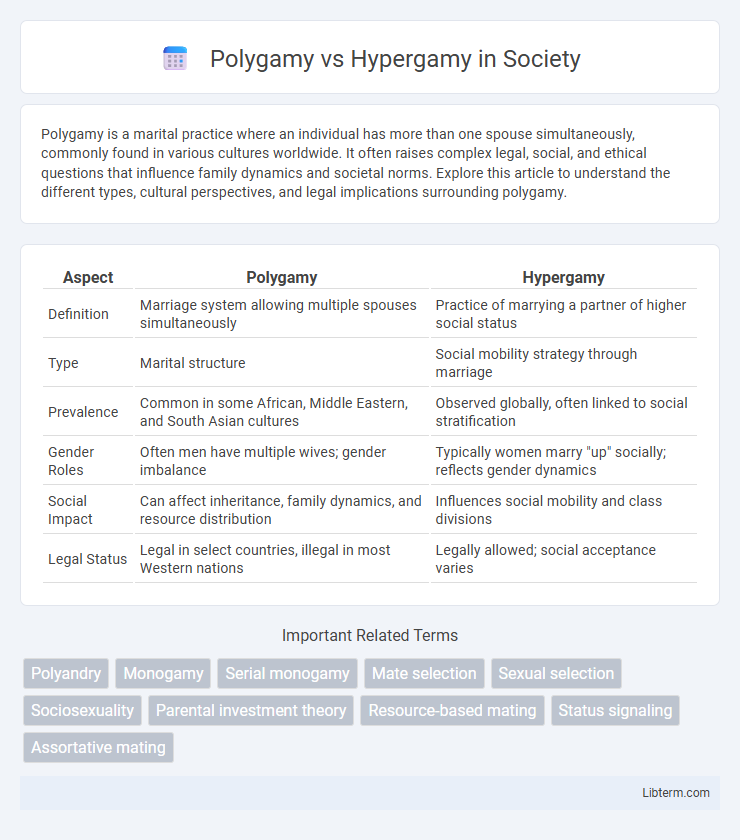Polygamy is a marital practice where an individual has more than one spouse simultaneously, commonly found in various cultures worldwide. It often raises complex legal, social, and ethical questions that influence family dynamics and societal norms. Explore this article to understand the different types, cultural perspectives, and legal implications surrounding polygamy.
Table of Comparison
| Aspect | Polygamy | Hypergamy |
|---|---|---|
| Definition | Marriage system allowing multiple spouses simultaneously | Practice of marrying a partner of higher social status |
| Type | Marital structure | Social mobility strategy through marriage |
| Prevalence | Common in some African, Middle Eastern, and South Asian cultures | Observed globally, often linked to social stratification |
| Gender Roles | Often men have multiple wives; gender imbalance | Typically women marry "up" socially; reflects gender dynamics |
| Social Impact | Can affect inheritance, family dynamics, and resource distribution | Influences social mobility and class divisions |
| Legal Status | Legal in select countries, illegal in most Western nations | Legally allowed; social acceptance varies |
Defining Polygamy: Concepts and Cultural Contexts
Polygamy refers to the practice of having multiple spouses simultaneously, commonly observed in cultural contexts such as certain African, Middle Eastern, and South Asian societies where it is often legally and socially sanctioned. This marital structure typically involves one man married to several women (polygyny), although less commonly, one woman may have multiple husbands (polyandry). Understanding polygamy requires examining its cultural, religious, and socio-economic factors that shape family dynamics and gender roles in societies where it remains prevalent.
Hypergamy Explained: Social and Biological Perspectives
Hypergamy, the practice of seeking a partner of higher social or economic status, is rooted in both social and biological factors that influence mate selection. Socially, it reflects hierarchical structures where individuals strive for upward mobility and improved resources through relationships. Biologically, hypergamy aligns with evolutionary strategies aimed at securing better protection, access to resources, and enhanced offspring survival, contributing to its persistent presence across cultures.
Historical Roots of Polygamy and Hypergamy
Polygamy, historically rooted in agricultural and pastoral societies, emerged as a strategy to increase labor force and ensure lineage continuity by allowing one individual, typically a man, to have multiple spouses. Hypergamy, the social practice of marrying "up" in socioeconomic status, finds its origins in hierarchical societies where women sought to improve their social standing and secure economic stability through strategically advantageous marriages. Both practices reflect adaptive responses to social, economic, and cultural structures shaping family formation across civilizations.
Evolutionary Psychology: Why Humans Practice Polygamy and Hypergamy
Evolutionary psychology explains polygamy as a reproductive strategy where males maximize their genetic legacy by mating with multiple females, ensuring greater offspring survival and diversity. Hypergamy, often observed in mate selection, reflects an adaptive preference for partners with higher resource acquisition or social status, increasing offspring viability. These practices are deeply rooted in evolutionary pressures shaping human mating behaviors to enhance reproductive success and genetic propagation.
Polygamy Across Societies: Patterns and Prevalence
Polygamy, characterized by one individual having multiple spouses simultaneously, exhibits diverse patterns and prevalence across societies, with polygyny being most common in regions like Sub-Saharan Africa and parts of the Middle East. Social, economic, and cultural factors deeply influence its practice, often linked to male status, wealth distribution, and family alliances. Anthropological studies highlight how polygamy persists more in agrarian and pastoral communities where labor and lineage continuation bear significant importance.
Hypergamy in Modern Relationships and Dating
Hypergamy, the practice of seeking a partner of higher social, economic, or educational status, plays a crucial role in modern relationships and dating dynamics, influencing mate selection and dating preferences. Data from contemporary dating platforms reveal a significant trend where individuals prioritize partners with better financial stability and career prospects, reflecting hypergamous behavior. This contrasts with polygamy, which involves multiple simultaneous spouses, as hypergamy centers on social mobility within monogamous partnership frameworks prevalent in modern societies.
Polygamy vs Hypergamy: Key Differences and Overlaps
Polygamy involves multiple spouses simultaneously, often rooted in cultural or religious practices, while hypergamy refers to the social phenomenon where individuals marry into higher socioeconomic or social status. Polygamy centers on marital structure, whereas hypergamy emphasizes social mobility through marriage. Both intersect in societies where polygamous arrangements may reinforce hypergamous patterns by enabling higher-status individuals to form multiple alliances.
Impact on Gender Roles and Social Structure
Polygamy often reinforces traditional gender roles by institutionalizing male authority and female subordination, affecting family dynamics and inheritance patterns. Hypergamy influences social structure by encouraging women to marry upward, which can perpetuate economic disparities and social stratification. Both practices shape gender expectations and power relations, impacting community cohesion and individual agency within societies.
Legal, Ethical, and Moral Considerations
Polygamy involves multiple spouses simultaneously, often facing complex legal challenges including varying regulations across countries that may criminalize or restrict the practice. Hypergamy, the act of marrying someone of higher social status, raises ethical debates about social inequality and gender dynamics but lacks direct legal constraints. Both concepts intersect with moral considerations, where polygamy is scrutinized for potential exploitation and rights infringement, while hypergamy prompts discussions on societal values and the autonomy of partner choice.
The Future of Mating Strategies: Trends and Predictions
Future mating strategies indicate a shift as hypergamy adapts to modern socio-economic dynamics, prioritizing status and resource acquisition over traditional polygamous structures. Advances in gender equality and digital matchmaking platforms intensify competition and choice, influencing partner selection criteria toward emotional compatibility and individual success. Predictive models suggest emerging hybrid strategies blending selective hypergamous preferences with flexible relationship formats beyond classical polygamy.
Polygamy Infographic

 libterm.com
libterm.com